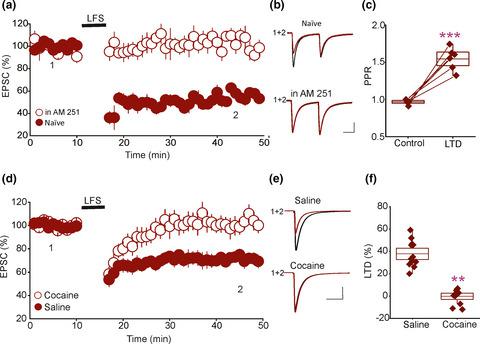当前位置:
X-MOL 学术
›
Eur. J. Nerosci.
›
论文详情
Our official English website, www.x-mol.net, welcomes your feedback! (Note: you will need to create a separate account there.)
Cocaine self-administration abolishes endocannabinoid-mediated long-term depression of glutamatergic synapses in the ventral tegmental area.
European Journal of Neroscience ( IF 3.4 ) Pub Date : 2020-09-21 , DOI: 10.1111/ejn.14980 Ruixiang Wang 1 , Kathryn A Hausknecht 1 , Amy M Gancarz-Kausch 1, 2 , Saida Oubraim 1 , Roh-Yu Shen 1 , Samir Haj-Dahmane 1
European Journal of Neroscience ( IF 3.4 ) Pub Date : 2020-09-21 , DOI: 10.1111/ejn.14980 Ruixiang Wang 1 , Kathryn A Hausknecht 1 , Amy M Gancarz-Kausch 1, 2 , Saida Oubraim 1 , Roh-Yu Shen 1 , Samir Haj-Dahmane 1
Affiliation

|
Drugs of abuse, including cocaine, alter the mechanisms underpinning synaptic plasticity, including long‐term potentiation of glutamatergic synapses in the mesolimbic system. These effects are thought to underlie addictive behaviors. In the ventral tegmental area (VTA), glutamatergic synapses also exhibit long‐term depression (LTD), a type of plasticity that weakens synaptic strength. This form of synaptic plasticity is induced by low‐frequency stimulation and mediated by endocannabinoid (eCB) signaling, which also modulates addictive behaviors. However, it remains unknown whether eCB‐LTD in the VTA could be altered by cocaine use. Therefore, the goal of the present study was to examine the impact of cocaine self‐administration on eCB‐LTD of glutamatergic synapses onto VTA dopaminergic (DA) neurons. To that end, male rats underwent cocaine (0.75 mg/kg/infusion) or saline self‐administration under the fixed ratio 1 schedule for 6–9 days. One day after the last self‐administration session, the magnitude of eCB‐LTD was examined using ex vivo whole‐cell recordings of putative VTA DA neurons from naïve rats and rats with saline or cocaine self‐administration. The results revealed that cocaine self‐administration abolished eCB‐LTD. The cocaine‐induced blockade of eCB‐LTD in the VTA was mediated by an impaired function of presynaptic CB1 receptors. Collectively, these findings indicate that cocaine exposure blunts eCB‐mediated synaptic plasticity in midbrain DA neurons. This effect could be one of the cellular mechanisms that mediate, at least in part, addictive behaviors.
中文翻译:

可卡因自我给药消除了内源性大麻素介导的腹侧被盖区谷氨酸能突触的长期抑制。
滥用药物,包括可卡因,会改变支持突触可塑性的机制,包括中脑边缘系统中谷氨酸能突触的长期增强。这些影响被认为是成瘾行为的基础。在腹侧被盖区 (VTA),谷氨酸能突触也表现出长期抑制 (LTD),这是一种削弱突触强度的可塑性。这种形式的突触可塑性由低频刺激诱导,并由内源性大麻素 (eCB) 信号介导,后者也调节成瘾行为。然而,VTA 中的 eCB-LTD 是否会因使用可卡因而改变仍然未知。因此,本研究的目的是检查可卡因自我给药对谷氨酸能突触 eCB-LTD 对 VTA 多巴胺能 (DA) 神经元的影响。为此,雄性大鼠接受了可卡因 (0. 75 mg/kg/输注)或生理盐水自我给药,按固定比例 1 计划给药 6-9 天。在最后一次自我给药后一天,使用来自幼稚大鼠和生理盐水或可卡因自我给药大鼠的推定 VTA DA 神经元的离体全细胞记录来检查 eCB-LTD 的大小。结果表明,可卡因自我给药废除了 eCB-LTD。VTA 中可卡因诱导的 eCB-LTD 阻断是由突触前 CB1 受体功能受损介导的。总的来说,这些发现表明可卡因暴露减弱了中脑 DA 神经元中 eCB 介导的突触可塑性。这种效应可能是介导(至少部分)成瘾行为的细胞机制之一。在最后一次自我给药后一天,使用来自幼稚大鼠和生理盐水或可卡因自我给药大鼠的推定 VTA DA 神经元的离体全细胞记录来检查 eCB-LTD 的大小。结果表明,可卡因自我给药废除了 eCB-LTD。VTA 中可卡因诱导的 eCB-LTD 阻断是由突触前 CB1 受体功能受损介导的。总的来说,这些发现表明可卡因暴露减弱了中脑 DA 神经元中 eCB 介导的突触可塑性。这种效应可能是介导(至少部分)成瘾行为的细胞机制之一。在最后一次自我给药后一天,使用来自幼稚大鼠和生理盐水或可卡因自我给药大鼠的推定 VTA DA 神经元的离体全细胞记录来检查 eCB-LTD 的大小。结果表明,可卡因自我给药废除了 eCB-LTD。VTA 中可卡因诱导的 eCB-LTD 阻断是由突触前 CB1 受体功能受损介导的。总的来说,这些发现表明可卡因暴露减弱了中脑 DA 神经元中 eCB 介导的突触可塑性。这种效应可能是介导(至少部分)成瘾行为的细胞机制之一。结果表明,可卡因自我给药废除了 eCB-LTD。VTA 中可卡因诱导的 eCB-LTD 阻断是由突触前 CB1 受体功能受损介导的。总的来说,这些发现表明可卡因暴露减弱了中脑 DA 神经元中 eCB 介导的突触可塑性。这种效应可能是介导(至少部分)成瘾行为的细胞机制之一。结果表明,可卡因自我给药废除了 eCB-LTD。VTA 中可卡因诱导的 eCB-LTD 阻断是由突触前 CB1 受体功能受损介导的。总的来说,这些发现表明可卡因暴露减弱了中脑 DA 神经元中 eCB 介导的突触可塑性。这种效应可能是介导(至少部分)成瘾行为的细胞机制之一。
更新日期:2020-09-30
中文翻译:

可卡因自我给药消除了内源性大麻素介导的腹侧被盖区谷氨酸能突触的长期抑制。
滥用药物,包括可卡因,会改变支持突触可塑性的机制,包括中脑边缘系统中谷氨酸能突触的长期增强。这些影响被认为是成瘾行为的基础。在腹侧被盖区 (VTA),谷氨酸能突触也表现出长期抑制 (LTD),这是一种削弱突触强度的可塑性。这种形式的突触可塑性由低频刺激诱导,并由内源性大麻素 (eCB) 信号介导,后者也调节成瘾行为。然而,VTA 中的 eCB-LTD 是否会因使用可卡因而改变仍然未知。因此,本研究的目的是检查可卡因自我给药对谷氨酸能突触 eCB-LTD 对 VTA 多巴胺能 (DA) 神经元的影响。为此,雄性大鼠接受了可卡因 (0. 75 mg/kg/输注)或生理盐水自我给药,按固定比例 1 计划给药 6-9 天。在最后一次自我给药后一天,使用来自幼稚大鼠和生理盐水或可卡因自我给药大鼠的推定 VTA DA 神经元的离体全细胞记录来检查 eCB-LTD 的大小。结果表明,可卡因自我给药废除了 eCB-LTD。VTA 中可卡因诱导的 eCB-LTD 阻断是由突触前 CB1 受体功能受损介导的。总的来说,这些发现表明可卡因暴露减弱了中脑 DA 神经元中 eCB 介导的突触可塑性。这种效应可能是介导(至少部分)成瘾行为的细胞机制之一。在最后一次自我给药后一天,使用来自幼稚大鼠和生理盐水或可卡因自我给药大鼠的推定 VTA DA 神经元的离体全细胞记录来检查 eCB-LTD 的大小。结果表明,可卡因自我给药废除了 eCB-LTD。VTA 中可卡因诱导的 eCB-LTD 阻断是由突触前 CB1 受体功能受损介导的。总的来说,这些发现表明可卡因暴露减弱了中脑 DA 神经元中 eCB 介导的突触可塑性。这种效应可能是介导(至少部分)成瘾行为的细胞机制之一。在最后一次自我给药后一天,使用来自幼稚大鼠和生理盐水或可卡因自我给药大鼠的推定 VTA DA 神经元的离体全细胞记录来检查 eCB-LTD 的大小。结果表明,可卡因自我给药废除了 eCB-LTD。VTA 中可卡因诱导的 eCB-LTD 阻断是由突触前 CB1 受体功能受损介导的。总的来说,这些发现表明可卡因暴露减弱了中脑 DA 神经元中 eCB 介导的突触可塑性。这种效应可能是介导(至少部分)成瘾行为的细胞机制之一。结果表明,可卡因自我给药废除了 eCB-LTD。VTA 中可卡因诱导的 eCB-LTD 阻断是由突触前 CB1 受体功能受损介导的。总的来说,这些发现表明可卡因暴露减弱了中脑 DA 神经元中 eCB 介导的突触可塑性。这种效应可能是介导(至少部分)成瘾行为的细胞机制之一。结果表明,可卡因自我给药废除了 eCB-LTD。VTA 中可卡因诱导的 eCB-LTD 阻断是由突触前 CB1 受体功能受损介导的。总的来说,这些发现表明可卡因暴露减弱了中脑 DA 神经元中 eCB 介导的突触可塑性。这种效应可能是介导(至少部分)成瘾行为的细胞机制之一。



























 京公网安备 11010802027423号
京公网安备 11010802027423号